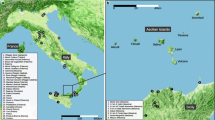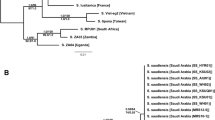Abstract
The nomadic, swarm-raiding army ant Labidus praedator (Smith, 1858) is an important arthropod predator in the Neotropics with a strong ecological impact on invertebrate communities. However, despite its high abundance and ubiquity over a large distribution range, it received relatively little scientific attention. Moreover, the taxonomic status is confusing because some morphological descriptions point towards the co-occurrence of several distinct taxa which are lumped together as L. praedator in most classical keys. Yet, clarifying genetic studies are lacking. Here, we show strong genetic differentiation within an L. praedator population in Mexico. Both microsatellite genotype patterns and phylogenetic analyses (concatenated nuclear and mtDNA sequences, including the coxI genetic barcoding region), reveal the occurrence of two strongly isolated lineages. Colonies from the very same location, clearly identified as the same species (L. praedator) according to classical morphological keys, exhibit an extremely high average sequence divergence (9.7–12.8 %), which was well in the range of divergence among GenBank sequences from other Labidus species. Thus, our data very likely show genetic differentiation at species level or cryptic speciation within L. praedator, which should be recognized when investigating biodiversity and ecological importance of army ants (or other arthropods) in the Neotropics.




Similar content being viewed by others
References
Avise JC (2000) Phylogeography: the history and formation of species. Harvard University Press, Cambridge, p 447
Barth MB, Moritz RFA, Pirk CWW, Kraus FB (2013) Male-biased dispersal promotes large scale gene flow in a subterranean army ant, Dorylus (Typhlopone) fulvus. Popul Ecol 55:523–533
Barth MB, Moritz RFA, Kraus FB (2014) The evolution of extreme polyandry in social insects: insights from army ants. PLoS One 9:e105621
Bensasson D, Zhang D, Hartl D, Hewitt G (2001) Mitochondrial pseudogenes: evolution’s misplaced witnesses. Trends Ecol Evol 16:314–321
Berghoff SM, Kronauer DJC, Edwards KJ, Franks NR (2008) Dispersal and population structure of a New World predator, the army ant Eciton burchellii. J Evol Biol 21:1125–1132
Boomsma JJ, Ratnieks FLW (1996) Paternity in Eusocial Hymenoptera. Philos Trans R Soc Lond B Biol Sci 351:947–975
Borgmeier T (1955) Die Wanderameisen der Neotropischen Region. Stud Entomol 3:1–720
Brady SG (2003) Evolution of the army ant syndrome: the origin and long-term evolutionary stasis of a complex of behavioral and reproductive adaptations. Proc Natl Acad Sci USA 100:6575–6579
Denny AJ, Franks NR, Edwards KJ (2004) Eight highly polymorphic microsatellite markers for the army ant Eciton burchellii. Mol Ecol Notes 4:234–236
Fisher BL, Smith MA (2008) A revision of Malagasy species of Anochetus Mayr and Odontomachus Latreille (Hymenoptera: Formicidae). PLoS One 3:e1787
Fournier D, Tindo M, Kenne M, Mbenoun Masse PS, Van Bossche V, De Coninck E, Aron S (2012) Genetic structure, nestmate recognition and behaviour of two cryptic species of the invasive big-headed ant Pheidole megacephala. PLoS One 7:e31480
Fowler HG (1979) Notes on Labidus praedator (Fr. Smith) in Paraguay (Hymenoptera: Formicidae: Dorylinae: Ecitonini). J Nat Hist 13:3–10
Franks NR (1982) Social insects in the aftermath of swarm raids of the army ant Eciton burchelli. In: Breed MD, Michener CD, Evans HE (eds) The biology of social insects: proceedings, ninth congress, International Union For The Study Of Social Insects, Boulder, Colorado, August 1982. Westview Press, Boulder, pp 275–279
Franks NR, Bossert WH (1983) The influence of swarm raiding army ants on the patchiness and diversity of a tropical leaf litter ant community. In: Sutton S, Whitmore T, Chadwick A (eds) Tropical rain forest: ecology and management. Blackwell Publishing, Oxford, pp 151–163
Gotwald WH (1995) Army ants: the biology of social predation. Comstock, Ithaca, p 302
Goudet J (1995) FSTAT (version 1.2): a computer program to calculate F-statistics. J Hered 86:485–486
Hall BG (2013) Building phylogenetic trees from molecular data with MEGA. Mol Biol Evol 30:1229–1235
Hebert PDN, Cywinska A, Ball SL, DeWaard JR (2003a) Biological identifications through DNA barcodes. Proc R Soc Lond B Biol Sci 270:313–321
Hebert PDN, Ratnasingham S, DeWaard JR (2003b) Barcoding animal life: cytochrome c oxidase subunit 1 divergences among closely related species. Proc R Soc Lond B Biol Sci 270:S96–S99
Hebert PDN, Penton EH, Burns JM, Janzen DH, Hallwachs W (2004) Ten species in one: DNA barcoding reveals cryptic species in the Neotropical skipper butterfly Astraptes fulgerator. Proc Natl Acad Sci USA 101:14812–14817
Jaffé R, Moritz RFA, Kraus FB (2009) Gene flow is maintained by polyandry and male dispersal in the army ant Eciton burchellii. Popul Ecol 51:227–236
Kalinowski ST (2005) HP-RARE 1.0: a computer program for performing rarefaction on measures of allelic richness. Mol Ecol Notes 5:187–189
Kaspari M, O’Donnell S (2003) High rates of army ant raids in the Neotropics and implications for ant colony and community structure. Evol Ecol Res 5:933–939
Kaspari M, Powell S, Lattke J, O’Donnell S (2011) Predation and patchiness in the tropical litter: do swarm-raiding army ants skim the cream or drain the bottle? J Anim Ecol 80:818–823
Kronauer DJC (2009) Recent advances in army ant biology (Hymenoptera: Formicidae). Myrmecol News 12:51–65
Kronauer DJC, Boomsma JJ, Gadau J (2004) Microsatellite markers for the driver ant Dorylus (Anomma) molestus. Mol Ecol Notes 4:289–290
Kronauer DJC, Johnson RA, Boomsma JJ (2007) The evolution of multiple mating in army ants. Evolution 61:413–422
Longino JT (2005) Ants of Costa Rica. http://academic.evergreen.edu/projects/ants/AntsofCostaRica.html
Longino JT, Coddington J, Colwell RK (2002) The ant fauna of a tropical rain forest: estimating species richness three different ways. Ecology 83:689–702
Moilanen A, Sundström L, Pedersen JS (2004) MATESOFT: a program for deducing parental genotypes and estimating mating system statistics in haplodiploid species. Mol Ecol Notes 4:795–797
Nei M, Kumar S (2000) Molecular evolution and phylogenetics. Oxford University Press, New York
O’Donnell S, Lattke J, Powell S, Kaspari M (2007) Army ants in four forests: geographic variation in raid rates and species composition. J Anim Ecol 76:580–589
Rabeling C, Schultz TR, Pierce NE, Bacci M (2014) A social parasite evolved reproductive isolation from its fungus-growing ant host in sympatry. Curr Biol 24:2047–2052
Rettenmeyer CW (1963) Behavioral studies of army ants. Univ Kans Sci Bull 44:281–465
Rettenmeyer CW, Chadab-Crepet R, Naumann MG, Morales L (1983) Comparative foraging by neotropical army ants. In: Jaisson P (ed) Social insects in the tropics. Université Paris-Nord, Paris, pp 59–73
Schneirla TC (1971) Army ants: a study in social organization. W.H. Freeman, San Francisco, p 369
Seifert B (2009) Cryptic species in ants (Hymenoptera: Formicidae) revisited: we need a change in the alpha-taxonomic approach. Myrmecol News 12:149–166
Smith MA, Fisher BL, Hebert PDN (2005) DNA barcoding for effective biodiversity assessment of a hyperdiverse arthropod group: the ants of Madagascar. Philos Trans R Soc Lond B Biol Sci 360:1825–1834
Smith MA, Hallwachs W, Janzen DH (2014) Diversity and phylogenetic community structure of ants along a Costa Rican elevational gradient. Ecography 37:720–731
Tamura K, Nei M, Kumar S (2004) Prospects for inferring very large phylogenies by using the neighbor-joining method. Proc Natl Acad Sci USA 101:11030–11035
Tamura K, Peterson D, Peterson N, Stecher G, Nei M, Kumar S (2011) MEGA5: molecular evolutionary genetics analysis using maximum likelihood, evolutionary distance, and maximum parsimony methods. Mol Biol Evol 28:2731–2739
Walsh PS, Metzger DA, Higuchi R (1991) Chelex-100 as a medium for simple extraction of DNA for PCR-based typing from forensic material. Biotechniques 10:506–513
Watkins JF (1976) The identification and distribution of new world army ants (Dorylinae: Formicidae). Baylor University Press, Waco, p 102
Watkins JF (1982) Key to the army ants of Mexico. J Kans Entomol Soc 55:197–247
Acknowledgments
We thank D. Sanchez and O. Argüello from the ECOSUR research centre (El Colegio de la Frontera Sur, Tapachula, Mexico) for providing sampling permits and their help during field work, E. Stolle for assisting with morphological imaging, and D. Kleber and P. Leibe for technical support. Finances were granted by the Graduate Scholarship of Saxony Anhalt (MBB) and the Mexican-European FONCICYT 94293 Grant “MUTUAL” for travel expenses.
Author information
Authors and Affiliations
Corresponding author
Rights and permissions
About this article
Cite this article
Barth, M.B., Moritz, R.F.A. & Kraus, F.B. Genetic differentiation at species level in the Neotropical army ant Labidus praedator . Insect. Soc. 62, 299–306 (2015). https://doi.org/10.1007/s00040-015-0410-x
Received:
Revised:
Accepted:
Published:
Issue Date:
DOI: https://doi.org/10.1007/s00040-015-0410-x




